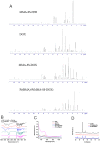Nano-gold micelles loaded Dox and Elacridar for reversing drug resistance of breast cancer
- PMID: 36341719
- PMCID: PMC10116014
- DOI: 10.1049/nbt2.12102
Nano-gold micelles loaded Dox and Elacridar for reversing drug resistance of breast cancer
Abstract
The aim of this study was to provide a new effective carrier for rescuing the sensitivity of drug-resistant in breast cancer cells. Nano-gold micelles loaded with Dox and Elacridar (FP-ssD@A-E) were chemically synthesised. With the increase in the amount of Dox and Elacridar, the encapsulation rate of FP-ssD@A-E gradually increased, and the drug loading rate gradually decreased. FP-ss@A-E had a sustained-release effect. Dox, Elacridar, FP-ss@AuNPs, and FP-ssD@A-E significantly improved cell apoptosis, in which, FP-ssD@A-E was the most significant. FP-ssD@A-E significantly decreased the cell viability and improved the Dox uptake. The levels of VEGFR-1, P-gp, IL-6, and i-NOS were significantly decreased after Dox, Dox + Elacridar, FP-ss@AuNPs, and FP-ssD@A-E treatment. It was worth noting that FP-ssD@A-E had the most significant effects. The prepared FP-ssD@A-E micelles, which were spherical in shape, uniform in particle size distribution, and had good drug loading performance and encapsulation efficiency.
Keywords: breast cancer; doxorubicin; drug loaded hybrid micelles; elacridar; gold nanoparticles.
© 2022 The Authors. IET Nanobiotechnology published by John Wiley & Sons Ltd on behalf of The Institution of Engineering and Technology.
Conflict of interest statement
The authors report that they have no declarations of interest.
Figures








Similar articles
-
Pluronic P123 modified nano micelles loaded with doxorubicin enhanced tumor-suppressing effect on drug-resistant breast cancer cells.Aging (Albany NY). 2020 May 12;12(9):8289-8300. doi: 10.18632/aging.103138. Epub 2020 May 12. Aging (Albany NY). 2020. PMID: 32396524 Free PMC article.
-
Smart pH-sensitive micelles based on redox degradable polymers as DOX/GNPs carriers for controlled drug release and CT imaging.Colloids Surf B Biointerfaces. 2018 Mar 1;163:29-40. doi: 10.1016/j.colsurfb.2017.12.008. Epub 2017 Dec 8. Colloids Surf B Biointerfaces. 2018. PMID: 29278801
-
Doxorubicin-Loaded Unimolecular Micelle-Stabilized Gold Nanoparticles as a Theranostic Nanoplatform for Tumor-Targeted Chemotherapy and Computed Tomography Imaging.Biomacromolecules. 2017 Dec 11;18(12):3869-3880. doi: 10.1021/acs.biomac.7b00810. Epub 2017 Oct 26. Biomacromolecules. 2017. PMID: 29032674
-
Targeted delivery of Doxorubicin by folic acid-decorated dual functional nanocarrier.Mol Pharm. 2014 Nov 3;11(11):4164-78. doi: 10.1021/mp500389v. Epub 2014 Sep 29. Mol Pharm. 2014. PMID: 25265550 Free PMC article.
-
99mTc-doxorubicin-loaded gallic acid-gold nanoparticles (99mTc-DOX-loaded GA-Au NPs) as a multifunctional theranostic agent.Int J Pharm. 2020 Aug 30;586:119514. doi: 10.1016/j.ijpharm.2020.119514. Epub 2020 Jun 18. Int J Pharm. 2020. PMID: 32565281
Cited by
-
Nanoformulations in Pharmaceutical and Biomedical Applications: Green Perspectives.Int J Mol Sci. 2024 May 27;25(11):5842. doi: 10.3390/ijms25115842. Int J Mol Sci. 2024. PMID: 38892030 Free PMC article. Review.
-
Optimizing Triple-Negative Breast Cancer Therapy via Ultrasound-Enhanced Piezocatalysis for Targeted Chemodrug Release.Int J Nanomedicine. 2025 Mar 6;20:2779-2796. doi: 10.2147/IJN.S505526. eCollection 2025. Int J Nanomedicine. 2025. PMID: 40066325 Free PMC article.
-
CAPRIN1 Transcriptionally Activated PLPP4 to Inhibit DOX Sensitivity and Promote Breast Cancer Progression.Cell Biochem Biophys. 2025 Jun;83(2):2035-2045. doi: 10.1007/s12013-024-01614-0. Epub 2024 Nov 18. Cell Biochem Biophys. 2025. PMID: 39556159
References
-
- Olsson, A. , Schubauer‐Berigan, M. , Schüz, J. : Strategies of the International Agency for Research on Cancer (IARC/WHO) to reduce the occupational cancer burden. Meditsina Tr. Promyshlennaia Ekol. 61(3), 140–154 (2021). 10.31089/1026-9428-2021-61-3-140-154 - DOI
-
- Esteva, F. , et al.: Immunotherapy and targeted therapy combinations in metastatic breast cancer. Lancet Oncol. 20(3), e175–e186 (2019) - PubMed
-
- Meng, G.G. , James, B.R. , Skov, K.A. : Porphyrin chemistry pertaining to the design of anti‐cancer drugs; part 1, the synthesis of porphyrins containing meso‐pyridyl and meso‐substituted phenyl functional groups. Can. J. Chem. 72(9), 2447–2457 (1994). 10.1139/v94-241 - DOI
MeSH terms
Substances
Grants and funding
LinkOut - more resources
Full Text Sources
Medical
Miscellaneous

